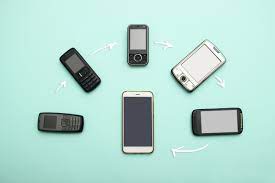Explaining the Smartphones and its impacts on Communication
The evolution of Smartphones and its impacts from their humble beginnings for cellular phones, smartphones have transformed into powerful.

In just a few decades, Smartphones and its impacts have transformed from clunky communication devices into indispensable companions in our daily lives.
The evolution of smartphones has been nothing short of remarkable, revolutionizing the way we communicate, work, and interact with the world.
In this blog post, we will delve into the fascinating journey of smartphones, exploring their technological advancements and the profound impact they have had on communication.
The Smartphones and its impacts
The concept of a "smartphone" as we know it today began to take shape in the early 1990s. Prior to this, mobile phones were primarily used for voice calls, with limited text messaging capabilities. However, visionaries in the tech industry foresaw a future where mobile devices could do more than just make calls.
In 1992, IBM introduced the Simon Personal Communicator, often considered the first true smartphone. It featured a touchscreen interface and could send emails and faxes, manage contacts, and even had a simple calendar. Although it was bulky and expensive, the Simon laid the foundation for what was to come.
The Rise of the Palm Pilot and BlackBerry
The late 1990s and early 2000s saw the emergence of two key players in the smartphone evolution: the Palm Pilot and BlackBerry. The Palm Pilot, introduced in 1996, was a pioneer in personal digital assistants (PDAs). It allowed users to manage their schedules, contacts, and notes, effectively combining the functionalities of a PDA with a mobile phone.
BlackBerry, on the other hand, targeted business professionals with its secure email and messaging capabilities. Released in 1999, the BlackBerry quickly gained popularity among executives and government officials for its reliable communication features.
These early smartphones, while not as versatile as today's models, laid the groundwork for the integration of productivity tools and communication features into a single device.
The Advent of the iPhone
The true turning point in the evolution of smartphones came in 2007 with the introduction of the first-generation iPhone by Apple. Steve Jobs, the co-founder of Apple, unveiled a device that combined a phone, an iPod, and an internet communicator. The iPhone's sleek design, intuitive interface, and App Store revolutionized the mobile industry.
The App Store allowed third-party developers to create applications for the iPhone, expanding its capabilities far beyond what came pre-installed.
Suddenly, smartphones were no longer just communication tools; they became platforms for endless possibilities. Games, social media apps, productivity tools, and more flooded the App Store, changing the way we work and play.
Android's Rise and Market Diversification
While Apple was making waves with the iPhone, Google was busy developing its own mobile operating system, Android. In 2008, the first Android-powered smartphone was released. Android's open-source nature allowed various manufacturers to produce a wide range of devices, catering to different preferences and budgets.
This diversification of the market gave consumers more choices and accelerated the adoption of smartphones worldwide. It also fueled fierce competition between Apple and Android, resulting in continuous innovation and rapid technological advancements.
The Era of Mobile Internet and Social Media
The widespread availability of mobile internet and the rise of social media platforms further transformed how we communicate through smartphones. Faster data connections, such as 3G and 4G, made it possible to browse the web, stream videos, and use data-intensive apps on the go. Social media apps like Facebook, Twitter, and Instagram brought people closer together, enabling real-time communication and sharing of experiences.
Smartphones became our primary devices for staying connected with friends and family, no matter where they were in the world. Messaging apps like WhatsApp, iMessage, and WeChat replaced traditional SMS messaging, offering free and instant communication through text, voice, and video.
The Evolution of Cameras and Multimedia
Smartphone cameras have come a long way since the early days of grainy, low-resolution photos. The integration of high-quality cameras and advanced imaging software has turned smartphones into powerful tools for capturing and sharing moments. The concept of "selfies" and the rise of platforms like Instagram and Snapchat have made visual communication an integral part of our lives.
Additionally, smartphones have become our portable entertainment hubs, with vibrant displays and powerful processors capable of running graphically demanding games, streaming high-definition videos, and delivering immersive virtual reality experiences.
The Impact on Work and Productivity
The evolution of smartphones has not only transformed our personal lives but has also had a significant impact on the way we work and do business. With the advent of mobile email clients, cloud storage, and productivity apps, professionals can now stay connected and productive no matter where they are.
The COVID-19 pandemic accelerated the adoption of remote work, and smartphones played a crucial role in this transition. Video conferencing apps like Zoom and Microsoft Teams allowed teams to collaborate and hold meetings from the comfort of their homes.
The ability to access work-related information and tools on smartphones has blurred the lines between the office and home, granting us greater flexibility in how and where we work.
The Rise of Artificial Intelligence (AI)
Artificial intelligence has become a key component of modern smartphones, enhancing their functionality and personalization. Voice assistants like Siri, Google Assistant, and Alexa have become integral parts of our daily routines, allowing us to control smart devices, set reminders, and answer questions with just our voices.
AI-driven algorithms power content recommendations on social media, streaming platforms, and news apps, creating personalized user experiences. Additionally, AI-driven camera features improve photo quality, enable facial recognition, and enhance augmented reality experiences.
The Future of Smartphones: 5G and Beyond
As we look to the future, the evolution of smartphones shows no signs of slowing down. The rollout of 5G networks promises even faster and more reliable connectivity, enabling new possibilities for communication and technology. Augmented reality (AR) and virtual reality (VR) applications are expected to become more prevalent, offering immersive and interactive experiences.
Foldable and flexible display technology is also on the horizon, potentially revolutionizing the form factor of smartphones. These advancements could lead to devices that can be both compact for everyday use and expansive for productivity or entertainment.
Moreover, sustainability is becoming a significant concern in the smartphone industry. Manufacturers are increasingly focusing on eco-friendly materials, energy efficiency, and recyclability to reduce their environmental impact.
In conclusion, the evolution of smartphones has been nothing short of revolutionary. From their humble beginnings as communication devices, they have become versatile tools that impact nearly every aspect of our lives.
Smartphones have reshaped how we communicate, work, entertain ourselves, and stay informed. As technology continues to advance, the future of smartphones holds even more exciting possibilities.
What's Your Reaction?
















